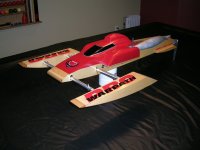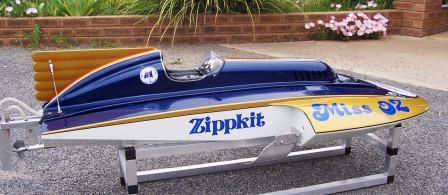Does anyone else do this?
Riggerman created the topic: Does anyone else do this?
I use an airplane propeller and tach to bench test my engines and gauge hp gain on mods done. Behind a plexiglass blast shield of course. ;D Without buying a dyno is there a better way? It has really worked great for me to break in engines and test the results of mods in a controlled measurable fashion. Also been very helpful when it comes to tuning an adjustable pipe.
Please Log in or Create an account to join the conversation.
- Riggerman
- Offline
- Posts: 42
- Thank you received: 0
marc replied the topic: Re: Does anyone else do this?
I have a home-built dyno and I also use the method you describe to break in engines and also get an engine and pipe up to temp before dyno pulls. Just by running the airplane prop you usually get a pretty good idea of whether the engine is good or bad.
"
Please Log in or Create an account to join the conversation.
- marc
-

- Offline
- Posts: 2491
- Karma: 24
- Thank you received: 55
Riggerman replied the topic: Re: Does anyone else do this?
Marc, Are there plans online to make a dyno? I would make one if I had some idea how. My experience with the automotive dynos led me to believe it was pretty sophisticated mechanically and software wise. I am fairly happy with this system except I don't feel comfortable making actual HP claims. The other problem is that tuning a wet pipe can get a little messy to say the least. For anyone thinking of doing this make sure to use a carbon fibre reinforced prop. The wood ones are only made to turn 9-12k rpm and we all know the fun doesn't start till you hit 17k ;D
Please Log in or Create an account to join the conversation.
- Riggerman
- Offline
- Posts: 42
- Thank you received: 0
marc replied the topic: Re: Does anyone else do this?
There are some good sites online to help with building your own dyno.
Here is one that helped me alot: www1.cedar-rapids.net/tdkmotor/DYNO.HTM
There are also many others...mostly for carts so search for cart dynos.
Here is one that helped me alot: www1.cedar-rapids.net/tdkmotor/DYNO.HTM
There are also many others...mostly for carts so search for cart dynos.
"
Please Log in or Create an account to join the conversation.
- marc
-

- Offline
- Posts: 2491
- Karma: 24
- Thank you received: 55
Bucky replied the topic: Re: Does anyone else do this?
Marc
what type of of Dyno do you Have?
How about some photos
what type of of Dyno do you Have?
How about some photos
Please Log in or Create an account to join the conversation.
- Bucky
-

- Offline
- Posts: 9
- Thank you received: 0
marc replied the topic: Re: Does anyone else do this?
It's a small inertia dyno built for personal use only. Wrote the software and used a small Data logger from Eagletree for the acquisition. Works nicely. Would not use it to claim numbers but it's proven to be pretty good for comparison purposes.
http://www.modelgasboats.com/media/kunena/attachments/legacy/images/2520_Dyno_021_jpgac316697be69e941e890c0465f801b89
http://www.modelgasboats.com/media/kunena/attachments/legacy/images/2520_Dyno_021_jpgac316697be69e941e890c0465f801b89
"
Last edit: 17 years 8 months ago by marc.
Please Log in or Create an account to join the conversation.
- marc
-

- Offline
- Posts: 2491
- Karma: 24
- Thank you received: 55
Please Log in or Create an account to join the conversation.
- Ed Sidders
- Offline
- Posts: 86
- Thank you received: 0
lohring replied the topic: Re: Does anyone else do this?
I would be very careful running propellers at the rpm a race engine can turn. We destroyed an engine and put a propeller blade through the side of Mike's shop during a test. Similar concerns apply to inertial dyno flywheels, but their destructive capacity is much higher. Our wheel is heat treated 4340 steel and I still worry when we turn over 20,000 rpm. So far we have only thrown magnets through the wall. Though our program (Performance Trends) says that the design isn't safe, my calculations indicate that we aren't exceeding the yield strength of the steel.
Lohring Miller
Lohring Miller
Please Log in or Create an account to join the conversation.
- lohring
- Offline
- Posts: 175
- Karma: -6
- Thank you received: 11
marc replied the topic: Re: Does anyone else do this?
I built this dyno a few years back, so I don't really remember 100% but the flywheel, if memory serves me correctly, was made from a piece of ground steel (same diameter as seen...was simply cut out of the piece) It was then bored for the main shaft that was machined for the bearings and then pressed into the flywheel. The complete assembly was then checked for trueness. I had this done by a professional machine shop that knew what it would be used for. The rest I built myself.
To the left lower side you can see the throttle handle hanging in the support that usually serves for airplane prop testing. The throttle is on a 3ft long cable that allows me to stand away from the engine on any side I want, depending on what I am testing. The pipe support is fully adjustable to match any pipe and engine position (dyno or airplane prop testing). When doing dyno pulls I stand from the angle seen in the pic with one hand on the brake (right side handle, secured to the stand) and throttle in other hand. Needless to say, I alway run this outdoors away from people or things that could be damaged in the event of a failure. I have been running this dyno since 2002. Have not gone to 20k very often. Zenoahs typically die down before that. I have done it though on some engines that were showing a "double hump". Regularly check everything including supports and bearings. I think the best way to keep safe is to use common sense and always "respect" the power you are dealing with. I work in the Natural gas industry, often having to deal with broken mains under high pressure and/or buildings filled with leaking gas...I am always a bit afraid even though fully trained to handle such situations. I have learned that "respecting" the powers you are dealing with is a good way to always be aware and cautious.
Dyno testing is very time consuming though and I don't really do much anymore.
To the left lower side you can see the throttle handle hanging in the support that usually serves for airplane prop testing. The throttle is on a 3ft long cable that allows me to stand away from the engine on any side I want, depending on what I am testing. The pipe support is fully adjustable to match any pipe and engine position (dyno or airplane prop testing). When doing dyno pulls I stand from the angle seen in the pic with one hand on the brake (right side handle, secured to the stand) and throttle in other hand. Needless to say, I alway run this outdoors away from people or things that could be damaged in the event of a failure. I have been running this dyno since 2002. Have not gone to 20k very often. Zenoahs typically die down before that. I have done it though on some engines that were showing a "double hump". Regularly check everything including supports and bearings. I think the best way to keep safe is to use common sense and always "respect" the power you are dealing with. I work in the Natural gas industry, often having to deal with broken mains under high pressure and/or buildings filled with leaking gas...I am always a bit afraid even though fully trained to handle such situations. I have learned that "respecting" the powers you are dealing with is a good way to always be aware and cautious.
Dyno testing is very time consuming though and I don't really do much anymore.
"
Please Log in or Create an account to join the conversation.
- marc
-

- Offline
- Posts: 2491
- Karma: 24
- Thank you received: 55
Riggerman replied the topic: Re: Does anyone else do this?
I always stand behind the blast shield and if I know the motor is gonna pull over 18k I put on a big winter coat and wear a full face motorcycle helmet. Looks funny but I feel safer...
Please Log in or Create an account to join the conversation.
- Riggerman
- Offline
- Posts: 42
- Thank you received: 0
Time to create page: 0.107 seconds
